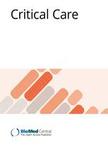版权所有:内蒙古大学图书馆 技术提供:维普资讯• 智图
内蒙古自治区呼和浩特市赛罕区大学西街235号 邮编: 010021

作者机构:Biomedical Engineering Program COPPE Federal University of Rio de Janeiro 21941-914 Rio de Janeiro Av. Horácio Macedo Brazil Fundação Oswaldo Cruz Instituto de Pesquisa Clinica Evandro Chagas e Laboratório de Imunofarmacologia IOC 21045-900 Rio de Janeiro Av Brasil 4365 Manguinhos Brazil National Institute of Cancer-1 ICU 20230-130 Rio de Janeiro Praça Cruz Vermelha Brazil Radiodiagnostic Service Clementino Fraga Filho Hospital Federal University of Rio de Janeiro 21-941-913 Rio de Janeiro R Professor Rodolpho Paulo Rocco 255 Brazil
出 版 物:《Critical Care》 (Crit. Care)
年 卷 期:2007年第11卷第4期
页 面:1-13页
学科分类:1002[医学-临床医学] 1011[医学-护理学(可授医学、理学学位)] 10[医学]
主 题:Continuous Positive Airway Pressure Acute Lung Injury Recruitment Manoeuvre Peep Level Lung Aeration
摘 要:Introduction: Protective ventilatory strategies have been applied to prevent ventilator-induced lung injury in patients with acute lung injury (ALI). However, adjustment of positive end-expiratory pressure (PEEP) to avoid alveolar de-recruitment and hyperinflation remains difficult. An alternative is to set the PEEP based on minimizing respiratory system elastance (Ers) by titrating PEEP. In the present study we evaluate the distribution of lung aeration (assessed using computed tomography scanning) and the behaviour of Ers in a porcine model of ALI, during a descending PEEP titration manoeuvre with a protective low tidal volume. Methods: PEEP titration (from 26 to 0 cmH2O, with a tidal volume of 6 to 7 ml/kg) was performed, following a recruitment manoeuvre. At each PEEP, helical computed tomography scans of juxta-diaphragmatic parts of the lower lobes were obtained during end-expiratory and end-inspiratory pauses in six piglets with ALI induced by oleic acid. The distribution of the lung compartments (hyperinflated, normally aerated, poorly aerated and non-aerated areas) was determined and the Ers was estimated on a breath-by-breath basis from the equation of motion of the respiratory system using the least-squares method. Results: Progressive reduction in PEEP from 26 cmH2O to the PEEP at which the minimum Ers was observed improved poorly aerated areas, with a proportional reduction in hyperinflated areas. Also, the distribution of normally aerated areas remained steady over this interval, with no changes in non-aerated areas. The PEEP at which minimal Ers occurred corresponded to the greatest amount of normally aerated areas, with lesser hyperinflated, and poorly and non-aerated areas. Levels of PEEP below that at which minimal Ers was observed increased poorly and non-aerated areas, with concomitant reductions in normally inflated and hyperinflated areas. Conclusion: The PEEP at which minimal Ers occurred, obtained by descending PEEP titra